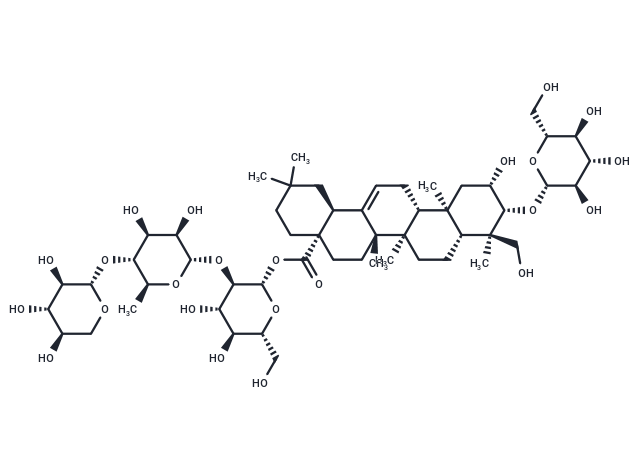 Your shopping cart is currently empty
Your shopping cart is currently empty

Polygalasaponin F has anti-neuroinflammatory activity, can inhibit the release of inflammatory cytokines TNF-α and NO induced by lipopolysaccharides (LPS) and reduce the expression of inducible nitric oxide synthases. Polygalasaponin F can significantly inhibit the cytotoxicity of conditioned medium prepared by LPS-stimulated BV-2 microglia (LPS conditioned media) to neuronal PC12 cells and improve cell viability. Polygalasaponin F can induce long-term potentiation in hippocampal dentate gyrus in anesthetized rats via NMDAR activation mediated by Ca(2+)/calmodulin-dependent kinase II, extracellular signal-regulated kinase and cAMP response element-binding protein signaling pathway. PS-F inhibits the secretions of neuroinflammatory cytokines by the regulation of the NF-kB-signaling pathway.

| Pack Size | Price | USA Warehouse | Global Warehouse | Quantity |
|---|---|---|---|---|
| 2 mg | $33 | In Stock | In Stock | |
| 5 mg | $50 | In Stock | In Stock | |
| 10 mg | $70 | In Stock | In Stock | |
| 25 mg | $113 | In Stock | In Stock | |
| 50 mg | $163 | In Stock | In Stock | |
| 100 mg | $239 | In Stock | In Stock | |
| 1 mL x 10 mM (in DMSO) | $120 | In Stock | In Stock |
| Description | Polygalasaponin F has anti-neuroinflammatory activity, can inhibit the release of inflammatory cytokines TNF-α and NO induced by lipopolysaccharides (LPS) and reduce the expression of inducible nitric oxide synthases. Polygalasaponin F can significantly inhibit the cytotoxicity of conditioned medium prepared by LPS-stimulated BV-2 microglia (LPS conditioned media) to neuronal PC12 cells and improve cell viability. Polygalasaponin F can induce long-term potentiation in hippocampal dentate gyrus in anesthetized rats via NMDAR activation mediated by Ca(2+)/calmodulin-dependent kinase II, extracellular signal-regulated kinase and cAMP response element-binding protein signaling pathway. PS-F inhibits the secretions of neuroinflammatory cytokines by the regulation of the NF-kB-signaling pathway. |
| Molecular Weight | 1091.24 |
| Formula | C53H86O23 |
| Cas No. | 882664-74-6 |
| Smiles | C[C@@H]1O[C@@H](O[C@@H]2[C@@H](O)[C@H](O)[C@@H](CO)O[C@H]2OC(=O)[C@]23CCC(C)(C)C[C@H]2C2=CC[C@@H]4[C@@]5(C)C[C@H](O)[C@H](O[C@@H]6O[C@H](CO)[C@@H](O)[C@H](O)[C@H]6O)[C@@](C)(CO)[C@@H]5CC[C@@]4(C)[C@]2(C)CC3)[C@H](O)[C@H](O)[C@H]1O[C@@H]1OC[C@@H](O)[C@H](O)[C@H]1O |
| Relative Density. | 1.48 g/cm3 at 20℃ |
| Storage | Powder: -20°C for 3 years | In solvent: -80°C for 1 year | Shipping with blue ice/Shipping at ambient temperature. | ||||||||||||||||||||||||||||||
| Solubility Information | DMSO: 60 mg/mL (54.98 mM), Sonication is recommended. | ||||||||||||||||||||||||||||||
| In Vivo Formulation | 10% DMSO+40% PEG300+5% Tween 80+45% Saline: 2 mg/mL (1.83 mM), Sonication is recommended. Please add the solvents sequentially, clarifying the solution as much as possible before adding the next one. Dissolve by heating and/or sonication if necessary. Working solution is recommended to be prepared and used immediately. The formulation provided above is for reference purposes only. In vivo formulations may vary and should be modified based on specific experimental conditions. | ||||||||||||||||||||||||||||||
Solution Preparation Table | |||||||||||||||||||||||||||||||
DMSO
| |||||||||||||||||||||||||||||||
| Size | Quantity | Unit Price | Amount | Operation |
|---|

Copyright © 2015-2025 TargetMol Chemicals Inc. All Rights Reserved.